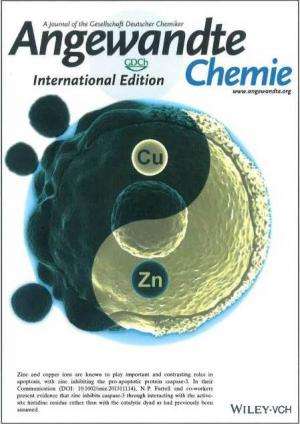Researchers identify how zinc regulates a key enzyme involved in cell death

The molecular details of how zinc, an essential trace element of human metabolism, interacts with the enzyme caspase-3, which is central to apoptosis or cell death, have been elucidated in a new study led by researchers at Virginia Commonwealth University. The study is featured on the cover of the April issue of the journal Angewandte Chemie International Edition.
Dysregulation of apoptosis is implicated in cancer and neurodegenerative disease such as Alzheimer's disease. Zinc is known to affect the process by inhibiting the activity of caspases, which are important drug targets for the treatment of the above conditions. The findings may help researchers design therapeutic agents that target zinc-caspase interaction to specifically control the activity of caspases, and hence, apoptosis.
"The work is unique in helping to open up a broad new area of research which we call the bioinorganic chemistry of apoptosis – understanding the role of essential metal ions in one of life's fundamental processes," said corresponding author Nicholas P. Farrell, Ph.D., member of the Developmental Therapeutics program at VCU Massey Cancer Center and professor of chemistry in the VCU College of Humanities and Sciences.
"Indeed, the zinc inhibition of apoptosis in fact contrasts with the role of its closely related neighbor copper, which is understood to enhance apoptosis," he said.
In the study, Farrell and his research team, A. Gerard Daniel, Ph.D., and Erica J. Peterson, used conventional enzymology and biophysical techniques combined with state-of-the-art computational methods, to show evidence for a hitherto unrecognized interaction site with caspase-3.
According to Farrell, caspases were discovered in the mid-1990s. There are 11 caspases known humans, and seven of these are involved in cell death. The study suggests a regulatory zinc site that may be common to all caspases. Previous findings have shown other zinc binding sites in caspase-6 and -9. Now, Farrell said, the generality of the team's observations must be extended and verified in other caspases.
"The [journal] cover epitomizes the contrasting but interdependent roles of the metal ions copper/zinc in the regulation of apoptosis and perfectly captures the duality of this most fundamental of biological processes," Farrell said.
More information: The study abstract can be found here: onlinelibrary.wiley.com/doi/10 … e.201401105/abstract.
Journal information: Angewandte Chemie International Edition
Provided by Virginia Commonwealth University




















